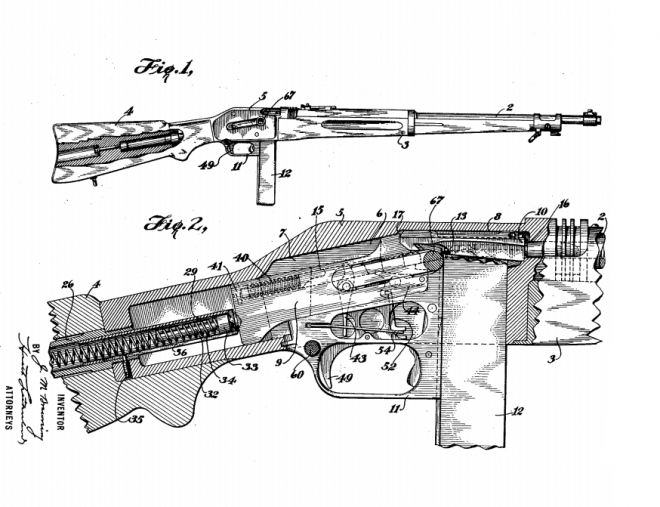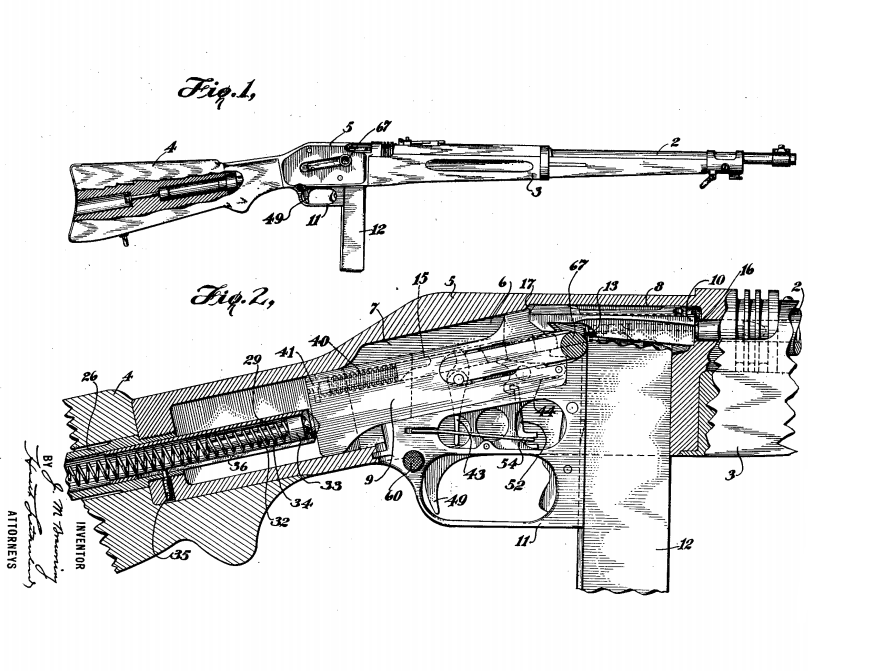Some of John Browning’s contributions to the effort of the First World War – like the M1918 Browning Automatic Rifle and the M1917 Browning Machine Gun – are well-known, but there’s one that never made it to production, or even any substantial degree of recognition: A Browning infantry rifle design, utilizing a totally unique hesitation locked mechanism.
While patent hunting for another article, I came across a patent of Browning’s that I didn’t recognize at all, much less had ever seen before. It was for a military semiautomatic rifle, equipped with all the necessary accouterments for bayonet fighting, with an extremely short receiver, and feeding from a large, detachable box magazine. Even more curiously, no information is readily available regarding the design online, which is very strange for a designer as well-studied as Browning. The patent is dated 1921, but its military nature makes it very likely to have been developed starting in 1917, or possibly even earlier. This is heavily supported by the 1922 date for the Browning Automatic Rifle patent, work on which began in 1917. In it, Browning describes a rifle with an extremely short receiver, made possible by an action that uses a floating breechblock to operate a downward-angled carrier. The breechblock was located in such a position that when the rifle fired, it slammed a short distance to the rear, but stopped against a protrusion in the receiver’s rear. This motion transferred energy to the carrier, which moved rearward, and after a short distance (enough for the bullet to fully exit the barrel and the pressure to drop, or as Browning describes it “to insure the expulsion of the gases arising from an explosion, forwardly through the front of the barrel”) cammed the bolt downward, unlocking it. This mechanism also made necessary the development of a unique fire control group, utilizing a linear hammer and cocking lever located in the carrier. The patent is embedded below:
At this point, only speculation is possible for what this rifle was. First, given my understanding of patent law at the time, there must have existed a prototype. Supporting that is the fact that Browning was the sort of person who cultivated his designs by shaping wood and metal into prototypes; he did not tend to work for very long with just theory. Therefore, I am certain that at least one of these rifles was actually made and tested, and knowing Browning who was not one to present a gun mechanically unfinished, it probably worked, though how well I can’t say. Although the patent does not describe the kind of ammunition intended for the weapon, the drawings do portray a rifle that fires short, straight-walled, round-nosed cartridges, which raises the question as to whether this was a competitor to John D. Pedersen’s “Cal. .30 Automatic Pistol Model of 1918”, better known as the Pedersen Device. If so, it’s not hard to see why Browning’s design gave way to Pedersen’s: It would have been much cheaper to modify existing M1903 rifles than to produce a whole new design! If Browning did intend to use a cartridge as small and weak as .30 Pedersen, though, why did he – no stranger to simple blowback – feel the need for such a sophisticated mechanism? Perhaps his rifle came with the advantage of firing vastly more powerful ammunition? Or was the prototype perhaps chambered for a reduced-power cartridge just to prove the mechanism could work?
A final note: Maj, General Julian S. Hatcher recalls in his book Hatcher’s Book of the Garand that Browning held John D. Pedersen in the highest respect, calling him “the greatest firearms designer alive”. Browning was very familiar with the younger Pedersen’s work even before U.S. entry into the war, having designed the basis for what Pedersen would later transform into the Model 17 shotgun at Remington. It’s not known when Browning confided his lofty opinion of Pedersen to Hatcher, but it’s certainly possible that it was during the self loading rifle trials of the 1920s. If that is so, it puts the quote into a very different context: Browning had first tackled many problems Pedersen had later proven able to solve. Pedersen had by that point successfully implemented a similar hesitation locking mechanism to the one Browning attempted, in his Model 51 and 53 pistols, and Pedersen was one of the first to ever design a truly satisfactory military selfloading rifle; the first ever recommended for adoption by the Army Ordnance Department, in fact. Browning may indeed have felt that Pedersen truly was picking up where he left off.
If anyone else knows anything about this rifle design, please let us known in the comments, or email me at nathaniel.f@staff.thefirearmblog.com!
 Your Privacy Choices
Your Privacy Choices

